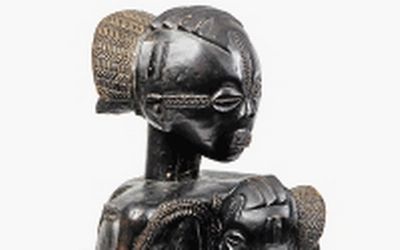AN IMPRESSIVE personal collection of African tribal art worth an estimated R4.5m will go on auction on Wednesday through Stephan Welz & Co in Constantia, Cape Town.
Spanning works from South Africa to Morocco, the collection belonging to retired African art dealer Colin Sayers consists of 312 pieces.
Sayers has decided to part with the collection since closing his Cape Town gallery — The Collector — in 2012.
It is a collection he built up since the early 1980s, when collecting African art was not seen as a worthwhile pursuit in South Africa.
“The top dealers have always been in Paris, Brussels and New York, and those who knew they had good items would sell there. Aside from what I could source locally, I bought on auction sales in these cities.
“When South Africa re-emerged from isolation, we got what we’d call runners coming here with rubbish, but there were a few good traders around. There just wasn’t a big tradition of collecting among South Africans, and there were few collectors.
“Traders found out quickly that we as a market didn’t know this art, and weren’t prepared to pay those prices,” Sayers said.
A deterrent to some amateur buyers is the issue of provenance of each item — something Sayers said even he could not always be certain about.
“It can be a minefield. When African countries were colonised, wood carvings which were not carved or used for ritual purpose were made to satisfy the taste of Europeans. These were made simply to sell.
“It’s still a thriving industry for the tourist market today. There are also copies that are made to deceive.
“I’ve been dealing since 1978, but nobody is infallible.
“Over the years you come to rely on comparisons with pieces that are known to be the real deal.”
Artists didn’t sign their work because the items were not simply art, and that wasn’t the tradition. Items such as carvings and masks were made to serve a ceremonial purpose, such as to house spirits.
“They were devices to help cure sicknesses or to calm down malevolent spirits.
“Nail fetishes from the Congo cease to be used today, but have been sold for $1m in New York. These fetishes had a muti bundle on their stomachs which interested the original users more than the carved figure itself.”
Sayers said the copies did not generally exhibit the beauty and quality of the originals, and it was unlikely you’d find the real thing in curio markets because early collectors and missionaries took many of the originals years ago.
“Most masking and carving for actual traditional use has died out.”
Anton Welz, director of Stephan Welz & Co, said most of the artworks on auction were sourced directly from tribes people as functional items.
Karel Nel, associate professor at the Wits School of Arts, said that among the lots to be sold were an inventory of Sotho and Xhosa pipes, Tsonga-Shangaan status staffs, compact Chokwe, Songo and Ovimbundu stools and a Chokwe throne as well as streamlined Lodzi vessels, distinctive Tutsi, Kuba and Zulu baskets and an array of small and large pieces from the Angola-Congo border.
“New York is increasingly becoming the centre of tribal art, so much so that this auction will be held in the afternoon and evening, timed so that American buyers can easily participate, either via telephone or live online bidding,” said Welz.
In the auction house’s October sale, 40% of tribal art sold went to US buyers and African traditional art is fetching good prices.
“In 2013, a Kongo-Yombe nail power figure from the DRC valued at $400,000 to $600,000 was sold at a Sotheby’s New York auction for over $1.8m.”
Pre-auction viewing is open to the public at no charge on Sunday from 10am to 5pm.
• This article was first published in Sunday Times: Business Times

FEEDING: A Luba Shankadi Mboko figure from the Congo
AN IMPRESSIVE personal collection of African tribal art worth an estimated R4.5m will go on auction on Wednesday through Stephan Welz & Co in Constantia, Cape Town.
Spanning works from South Africa to Morocco, the collection belonging to retired African art dealer Colin Sayers consists of 312 pieces.
Sayers has decided to part with the collection since closing his Cape Town gallery — The Collector — in 2012.
It is a collection he built up since the early 1980s, when collecting African art was not seen as a worthwhile pursuit in South Africa.
“The top dealers have always been in Paris, Brussels and New York, and those who knew they had good items would sell there. Aside from what I could source locally, I bought on auction sales in these cities.
“When South Africa re-emerged from isolation, we got what we’d call runners coming here with rubbish, but there were a few good traders around. There just wasn’t a big tradition of collecting among South Africans, and there were few collectors.
“Traders found out quickly that we as a market didn’t know this art, and weren’t prepared to pay those prices,” Sayers said.
A deterrent to some amateur buyers is the issue of provenance of each item — something Sayers said even he could not always be certain about.
“It can be a minefield. When African countries were colonised, wood carvings which were not carved or used for ritual purpose were made to satisfy the taste of Europeans. These were made simply to sell.
“It’s still a thriving industry for the tourist market today. There are also copies that are made to deceive.
“I’ve been dealing since 1978, but nobody is infallible.
“Over the years you come to rely on comparisons with pieces that are known to be the real deal.”
Artists didn’t sign their work because the items were not simply art, and that wasn’t the tradition. Items such as carvings and masks were made to serve a ceremonial purpose, such as to house spirits.
“They were devices to help cure sicknesses or to calm down malevolent spirits.
“Nail fetishes from the Congo cease to be used today, but have been sold for $1m in New York. These fetishes had a muti bundle on their stomachs which interested the original users more than the carved figure itself.”
Sayers said the copies did not generally exhibit the beauty and quality of the originals, and it was unlikely you’d find the real thing in curio markets because early collectors and missionaries took many of the originals years ago.
“Most masking and carving for actual traditional use has died out.”
Anton Welz, director of Stephan Welz & Co, said most of the artworks on auction were sourced directly from tribes people as functional items.
Karel Nel, associate professor at the Wits School of Arts, said that among the lots to be sold were an inventory of Sotho and Xhosa pipes, Tsonga-Shangaan status staffs, compact Chokwe, Songo and Ovimbundu stools and a Chokwe throne as well as streamlined Lodzi vessels, distinctive Tutsi, Kuba and Zulu baskets and an array of small and large pieces from the Angola-Congo border.
“New York is increasingly becoming the centre of tribal art, so much so that this auction will be held in the afternoon and evening, timed so that American buyers can easily participate, either via telephone or live online bidding,” said Welz.
In the auction house’s October sale, 40% of tribal art sold went to US buyers and African traditional art is fetching good prices.
“In 2013, a Kongo-Yombe nail power figure from the DRC valued at $400,000 to $600,000 was sold at a Sotheby’s New York auction for over $1.8m.”
Pre-auction viewing is open to the public at no charge on Sunday from 10am to 5pm.
• This article was first published in Sunday Times: Business Times






















Register/Login
Close XMy News
You can only set up or view personalised news headlines when you are logged in as a registered user. Thereafter you can choose the sectors of industry in which you are interested, and the latest articles from those sectors will display in this area of your console.
Login or Register.Top Stories
My Watchlist
You can only set up or view your share watchlist when you are logged in as a registered user. Thereafter you can select a list of companies and enter your share details to monitor their performance.
Login or Register.My Clippings
You can only clip articles when you are logged in as a registered user. Thereafter you can click on the "Read later" icon at the top of an article to save it to this area of your console, where you can return to read it at any time.
Login or Register.Change: -1.21%
Change: -1.31%
Change: -1.11%
Change: -1.12%
Change: -2.16%
Data supplied by Profile Data
Change: 0.00%
Change: 0.00%
Change: -1.21%
Change: 0.00%
Change: 0.00%
Data supplied by Profile Data
Change: -0.05%
Change: 0.05%
Change: 0.05%
Change: -0.09%
Change: -0.29%
Data supplied by Profile Data
Change: 0.00%
Change: 0.00%
Change: 0.00%
Change: 0.00%
Change: 0.00%
Data supplied by Profile Data